Altarscreen panels mounted in contemporary framework
- Antonio Molleno, American
- Born: New Mexico
- Active Dates: c. 1800 - c. 1850
Molleno worked as an artist in the Chimayó area of northern New Mexico from approximately 1800–1845. He is referred to as a santero—an artist who creates santos, or holy images. A scholar, E. Boyd, discovered a painting of Saint Francis with an inscription on the reverse that reads "San Francisco pitido [sic] el ano 1845 por el escultor Molleno.” “Saint Francis painted in the year 1845 by the sculptor Molleno.” Based on this inscription, art historians are able to attribute other works with matching characteristics to Molleno. During his career, Molleno developed three different styles of painting, referred to as his early, middle, and late periods. He moved from creating somewhat realistic figures to more simplified, abstract figures.
Altar screens were generally placed behind the altar in a church, or on the side walls. The painted wooden panels within the frame, called retablos, depict images of Catholic saints, the Christ Child, and the Virgin Mary. The wooden frame on this screen was designed and created by former Denver Art Museum curator Robert Stroessner, in order to show how the panels would have been displayed in a Catholic church in New Mexico. Santos, the holy images portrayed in the individual panels, served as devotional figures that played an important role in church, community, and family rituals. Saints provided a way for individuals to communicate with God. They are identified by visual attributes, or symbols that represent important aspects of their lives (see examples the "Details” section). Santos also served an educational purpose. The figures portrayed here would have been familiar to most of the church-going population in New Mexico during this time. Many of these people could not read, so images were used to tell stories, instead of the written word.
Details
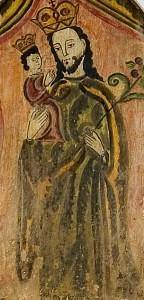
Saint Joseph and the Christ Child
The panel in the center of the top row shows Saint Joseph holding the Christ Child in his right arm, and holding a flowering staff in his left hand.
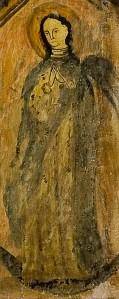
Virgin Mary
The Virgin Mary is located on the right side of the bottom row. She stands on a crescent moon wearing a blue cloak—two visual attributes associated with her.
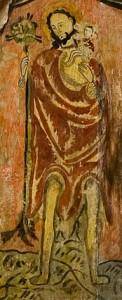
Saint Christopher
Saint Christopher, the patron saint of travelers, can be found in the bottom left panel. A child once asked Christopher to carry him across a river. As they made their way across, the child grew increasingly heavy and Christopher struggled. When they reached the other side, the child revealed himself as Christ, and told Christopher that he had just carried the weight of the world on his shoulders. Christopher planted his staff by the edge of the river where it became a palm tree. He is recognized by the staff he carries in his right hand and the Christ Child in his left.

Saint Barbara
Saint Barbara can be seen in the center panel with a tower in the background. The tower represents a story in which her jealous father locked her in a tower, claiming she was too beautiful to be seen.

Eyes
The eyes of the figures are simplified. A series of semi-circular lines make up the outline of each eye, and a dark dot is used to form the pupil.

Lips
A thin horizontal stripe of paint is crossed by short vertical lines to form the mouth. The lips, along with the eyes, are characteristic of Molleno’s more abstracted style.
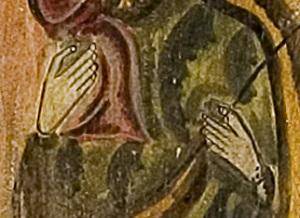
Hands
The hands of the figures are not realistic. The fingers are long, and the thumbs are distended and form awkward angles with the rest of the hand. Notice the disproportionate size of the hands on the image of the Christ Child.
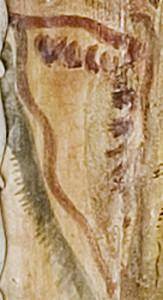
Chili Pepper Elements
The tables and draperies are stylized and look like triangular chili peppers. An earlier name given to Molleno—the “Chili Painter”—refers to his tendency to create these chili pepper designs.
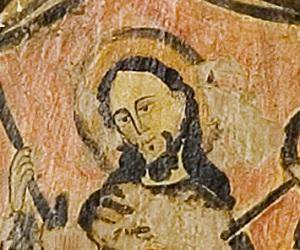
Head
The figures’ heads are turned slightly to the side, so that we are presented with a ¾ view of the face, with a portion of the right side hidden. This position is characteristic of Molleno’s style.
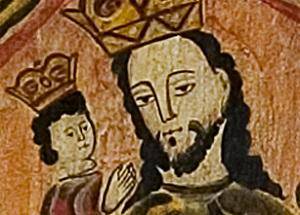
Nose and Beard
Molleno often gave attention to the nose and beard of the figures. Notice here the dark outline around the figures’ noses, and the solid beards on the male figures.
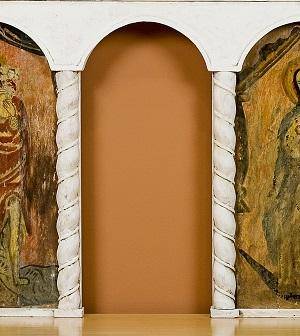
Empty Niche
The empty frame on the bottom row would probably have held a sculpture of a saint, called a bulto. Bultos were also made by santeros.
More Resources
Websites
Museum of Spanish Colonial Art
The website for this museum includes information about traditional Spanish Colonial art, with links.
Northern New Mexico’s Archive of Mountain Village Culture
A web archive with information about the people, artifacts and documents, activities, and community of Northern New Mexico.
Books
Awalt, Barbe and Paul Rhetts. Our Saints Among Us, 400 Years of New Mexican Devotional Art. Albuquerque: LPD Press, 1998.
A depiction of the culture and tradition of Santos in New Mexico.
Chavez, Fray Angelico. From an Altar Screen, Tales from New Mexico. Toronto: Ambassador Books Ltd., 1957.
New and old stories that form an "altar-screen" of the South West. Each story features a patron saint to which the character turns to for aid.
Cutter, Donald and Iris Engstrand. Quest for Empire, Spanish Settlement in the South West. Golden, Colorado: Fulcrum Publishers, 1996.
An exploration of how the introduction of European culture affected the native people of the Southwest, and how conquest and the mark of Christianity created a diverse group of people.
Espinosa, Jose E. Saints in the Valleys, Christian Sacred Images in the History, Life and Folk Art of Spanish New Mexico. Albuquerque: University of New Mexico Press, 1960.
A description of the European settlement in New Mexico, the Pueblo revolt, the transition and integration of cultures, and the resulting artistic techniques of Santos.
Loxton, Howard. The Encyclopedia of Saints. London: Brockhampton Press, 1996.
A book of many important saints, some portrayed in works of art.
Morgan, Tom. Saints, A Visual Almanac of the Virtuous, Pure, Praiseworthy and Good. California: Chronicle Books, 1994.
This book organizes saints by their feast days. Each saint has a biography, listed attributes and artwork.
Saari, Peggy. Colonial America Almanac, Volumes 1-3. United States: U.X.L., 2000.
This books explores the history of colonization in America and the related social issues. It also includes a look into other aspects of colonial life, such as economy, family, religion, and art.
Steele, Thomas J. Santos and Saints, The Religious Folk Art of Hispanic New Mexico. New Mexico: Ancient City Press, 1994.
An exploration of santos, accompanied by many examples.
Funding for object education resources provided by a grant from the Morgridge Family Foundation. Additional funding provided by the William Randolph Hearst Endowment for Education Programs, and Xcel Energy Foundation. We thank our colleagues at the University of Denver Morgridge College of Education.
The images on this page are intended for classroom use only and may not be reproduced for other reasons without the permission of the Denver Art Museum. This object may not currently be on display at the museum.
